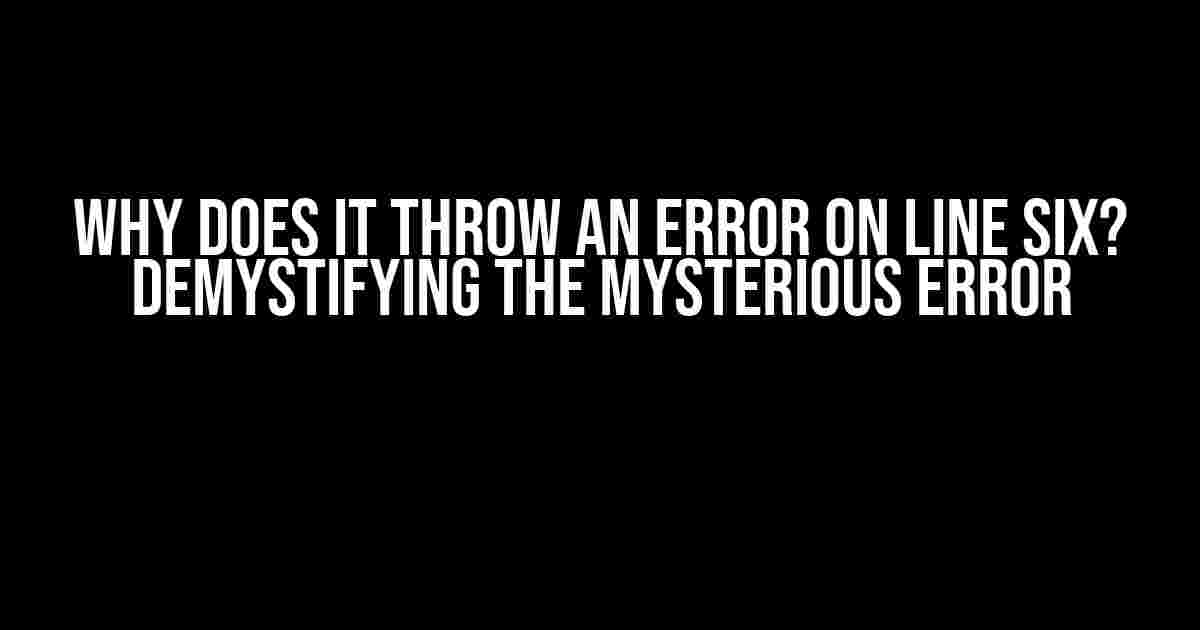If you’re reading this article, chances are you’ve stumbled upon an infuriating error that refuses to go away, and the dreaded phrase “error on line six” has become an all-too-familiar nemesis. Fear not, friend, for today we’re going to tackle this beast together! In this comprehensive guide, we’ll delve into the possible reasons behind this error, explore common pitfalls, and provide actionable solutions to get your code up and running in no time.
Understanding the Error
Before we dive into the nitty-gritty, let’s first understand what this error message is trying to tell us. When a programming language encounters an issue, it will often throw an error, which is simply a way of saying, “Hey, I’ve hit a roadblock, and I need your help to fix it!”
In this case, the error message “error on line six” is indicating that there’s a problem specifically on the sixth line of your code. But what could be causing this issue?
Possible Causes of the Error
There are several reasons why your code might be throwing an error on line six. Let’s explore some of the most common culprits:
Syntax Error: It’s possible that there’s a syntax error on line six. This could be a misplaced bracket, a forgotten semicolon, or a typo. Yes, typos can be sneaky!Variable Declaration: Are you trying to use a variable before it’s been declared? Perhaps you’re attempting to assign a value to an undefined variable?Function or Method Issues: Is there an issue with a function or method on line six? Maybe you’re trying to call a function that hasn’t been defined or is out of scope?External Library or Dependency Issues: Are you using an external library or dependency that’s causing the error? Perhaps there’s an issue with the library itself or the way you’re importing it?Logical Error: Sometimes, the error isn’t with the code itself but with the logic behind it. Are you making an incorrect assumption or using a flawed algorithm?
Troubleshooting Techniques
Now that we’ve explored some possible causes, let’s discuss some troubleshooting techniques to help you identify and fix the error:
Debugging: The first step in troubleshooting is to debug your code. This involves using tools like console logs, print statements, or a debugger to examine the values of variables, function calls, and execution flow.Code Review: Take a step back, and review your code line by line. Look for any syntax errors, typos, or logical flaws. Sometimes, a fresh pair of eyes can make all the difference!Isolate the Issue: Try to isolate the issue by commenting out sections of code or temporarily removing external dependencies. This can help you pinpoint the exact location of the error.Search Online: If you’re still stuck, search online for similar errors or issues. You might find a solution or a helpful forum thread that can guide you towards a fix.
Common Pitfalls to Avoid
As we troubleshoot, let’s avoid some common pitfalls that can lead to errors on line six:
// Example of a syntax error
if (x = 5) {
console.log("This will always be true!");
}
// Example of an undefined variable
console.log(undefinedVariable);
// Example of an incorrect function call
invalidFunction();
| Pitfall | Description |
|---|---|
| Assuming Default Values | Don’t assume default values for variables or function parameters. Make sure to initialize or define them explicitly. |
| Ignoring Error Messages | Don’t ignore error messages! They’re trying to tell you something. Take the time to read and understand the error message. |
| Overlooking Typos | Remember, typos can be sneaky. Take a closer look at your code and watch out for those pesky typos! |
Solutions and Workarounds
Now that we’ve identified the possible causes and troubleshooting techniques, let’s explore some solutions and workarounds for common errors on line six:
Syntax Error Solutions
Check Your Brackets: Make sure you’ve closed all brackets, parentheses, and curly braces correctly.Fix Typos: Double-check for typos in variable names, function calls, and syntax.Use a Linter: Consider using a linter or code formatter to help identify syntax errors and improve code readability.
Variable Declaration Solutions
Declare Variables Explicitly: Make sure to declare variables explicitly before using them.Use Let or Const: Consider using let or const instead of var to avoid variable hoisting issues.Check Scope: Double-check the scope of your variables and functions to ensure they’re accessible where needed.
Function or Method Solution
Check Function Signature: Verify the function signature, including the correct number and types of arguments.Ensure Function Existence: Make sure the function or method exists and is correctly imported or defined.Check External Library Issues: If using an external library, ensure it’s correctly installed, imported, and configured.
Conclusion
In conclusion, the “error on line six” can be a frustrating issue, but by understanding the possible causes, using troubleshooting techniques, and avoiding common pitfalls, you can overcome this hurdle and get your code running smoothly.
Remember, debugging is an essential part of the programming process. Take your time, stay patient, and don’t be afraid to ask for help. With practice and persistence, you’ll become a master troubleshooter and be able to tackle even the most elusive errors!
So, the next time you encounter an “error on line six,” don’t panic. Take a deep breath, grab a cup of coffee, and dive into the world of troubleshooting. Happy coding!
Frequently Asked Question
Get to the bottom of the elusive error on line six with our expert answers!
Why does my code throw an error on line six?
It’s likely that there’s a syntax error or a mistake in the code that’s causing the error. Check for any typos, missing brackets, or incorrect indentation. If you’re still stuck, try debugging your code step-by-step to identify the issue.
Is it possible that the error is caused by a preceding line of code?
Absolutely! Errors can often be caused by code earlier in the script. Make sure to check the lines preceding line six for any mistakes. It’s possible that a variable is being used before it’s declared, or a function is being called with the wrong arguments. Keep an eye out for any red flags!
Could the error be related to a library or framework I’m using?
That’s a great point! If you’re using a library or framework, it’s possible that there’s an issue with the integration or implementation. Check the documentation and any release notes to see if there are any known issues or bugs. You might also want to try updating the library or rolling back to a previous version to see if that resolves the issue.
Should I try debugging the code in a different environment or IDE?
Sometimes, a fresh perspective (or environment) can make all the difference! Try copying your code into a different IDE or environment to see if the error persists. This can help you identify if the issue is specific to your current setup or if it’s a more widespread problem. You might also want to try running the code on a different machine or operating system to rule out any system-specific issues.
What are some common mistakes that can cause errors on line six?
Ah-ha! Some common culprits include mismatched brackets, incorrect variable assignments, and forgotten semicolons. Also, be on the lookout for any syntax errors, such as using the wrong data type or incorrect function calls. If you’re still stumped, try breaking down your code into smaller chunks and testing each section individually to isolate the issue.


